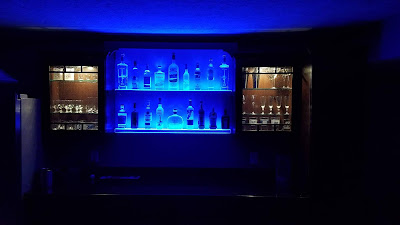Do you like to tinker? Do you like to learn new skills? Can you follow basic instructions or follow along with a video? Do you like to save substantial money? If you answered 'yes' to any of these, you may want to consider building your own smart home devices. This is actually easier than you think and doesn't require advanced tools, programming skills or a degree in electrical engineering. In fact, some devices can be build without soldering at all and without writing a single line of code.
A Real World Example
To give you a general idea of how simple and cost-effective it can be to build your own devices as opposed to buying, I'll take a page from my own home. Prior to launching on my own smart home adventure, we added a custom bar in our basement. I really wanted to have shelf lighting that lit up the bottles like you often see in bars or restaurants. Here is the original result:
 |
| (Before - with purchased LED lighting) |
The product came with a remote that allowed a selection from about 20 predefined colors and a handful of basic effects, such as fade and flash (this is the same basic remote you receive with nearly all purchased LED controllers):
Because of the position of the IR receiver, the remote always had to be used from just a few inches away from the shelf. In other words, I couldn't change colors from across the room. I needed two 4' shelves plus a daisy chain connector to link the two shelves together.
MY "BUY" COST: $460 (plus tax and shipping)
Jump forward a couple of years. I was well into the smart home process and had added custom LED lighting to things like the pool table and dart board. I realized that I could replace and upgrade the original bar lights at a fraction of the original cost, while gaining substantial new features. My parts list and costs:
8' LED Strip lights: $15 (1/2 of a 5M strip at $30)
5V 20A Power Supply: $25
Wemos D1 MIni microcontroller: $ 4
Wemos D1 MIni microcontroller: $ 4
Logic Level Shifter: $ 1
Push button (optional) $0.50
Misc. supplies (wire, breadboard): $ 6
WLED Software $ FREE
MY "BUILD COST: Approx. $50
To be fair, I did reuse the plastic shelves/housings from the original lights. But I'm sure a translucent shelf or some sort of housing with frosted Plexiglass could be built for far less than the $410 dollar difference! And my original version of this was built on a breadboard without any soldering or writing any code whatsoever.
In addition to the cost savings, I also gained the following features:
- Ability to control from anywhere in the house, via WiFi. This means the lights can be turned off/on, the colors and patterns set via voice, tablet/laptop, cell phone or Home Assistant. In addition, a simple push button can also toggle the lights.
- 16 million colors, with an unlimited number of custom presets.
- Over 100 different patterns and effects.
I'll post a detailed "how-to" for creating your own LED controller soon, but there are literally hundreds of YouTube videos on how to do this out there now. Do a simple search for WLED on YouTube if you want to get started now.
Easy to build devices
In addition to LED controllers, there are all sorts of other devices you can integrate into your smart home and automations that are easy to build and only cost a few dollars in components:
- Temperature and Humidity Sensors
- Motion sensors and detectors
- Light level sensors
- Garage or other door sensors
Conclusion
Before dropping your hard-earned money on a flashy existing smart home device, decide if that device meets your overall goals and rules and whether it will play nicely with your home platform. Consider whether you are willing to spend a little time, possibly do some light soldering and watch a video or two to build your own device that could save substantial dollars and better align with your home automation goals.





No comments:
Post a Comment
To help eliminate spam and to keep all conversations civil, submitted comments are moderated. Therefore your post may not show up immediately. Please be patient as most reviews are completed within a few hours.